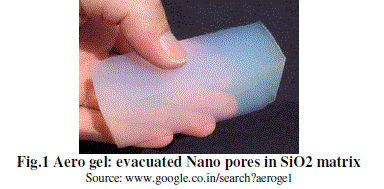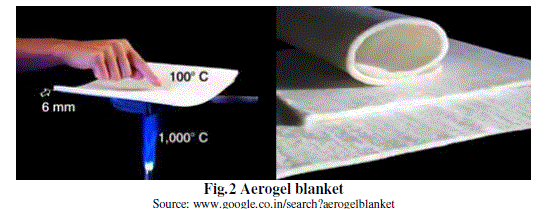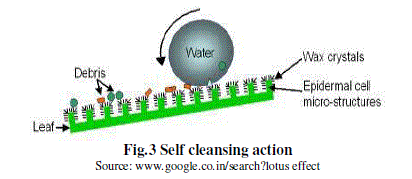ISSN ONLINE(2319-8753)PRINT(2347-6710)
ISSN ONLINE(2319-8753)PRINT(2347-6710)
Patel Abhiyan S. 1, Rathod Hiren A.2,Neeraj SharmaD3
|
| Related article at Pubmed, Scholar Google |
Visit for more related articles at International Journal of Innovative Research in Science, Engineering and Technology
Important feats in the construction industry were the invention of concrete in ancient Rome, the massproduction of steel from the mid-19th century and the mass-production of glass panes that changed from luxury to strength, likely others have similarly small to large changes with time. The paper focuses on questions like: What is nanotechnology? What can nanotechnology mean for the construction industry? Are there presently any commercialized products in construction that make use of nanotechnology? Construction can be defined as a process of converting the basic civil engineering raw materials to the final civil engineering product. Hence if the performance of the basic civil engineering raw materials is enhanced anyhow, the productivity will get increased as to work with those modified materials and the performance of the final civil engineering product will also be improved. Thus, the information presented in this paper is categorized into following main or basic raw materials: Cement, steel, paints, glass and fire protection materials, along with various definitions and basic concept of Nanotechnology.
Keywords |
| Nanotechnology, basic civil engineering raw materials, concrete, silica fume |
I. INTRODUCTION |
| A broad range of challenges are faced by the construction industry, ranging from the performance of the materials to environmental and safety issues related to basic materials and their properties. Recent developments in various areas of nanotechnology show significant promise in addressing many of these challenges. Research and developments have demonstrated that the application of nanotechnology can improve the performance of traditional construction materials, such as concrete, steel, glass, paint, coatings, insulating materials, et. al. Noteworthy improvements in concrete strength, durability and sustainability are being achieved with considered use of metal/metal oxide nanoparticles and engineered nanoparticles (carbon nanotubes and carbon Nano-fiber), and environment-responsive anticorrosion coatings formed using Nano encapsulation techniques are showing promise in laboratory settings. Research demonstrates that nanotechnology can contribute to novel cooling systems, and improve the functionality of solar cells and insulation. A range of nanomaterials are also being used to add new functionalities, such as self-cleaning properties, to traditional construction industry products, for example paint, glass, cement mortar and concrete. The application of nanotecnological innovations deals with a highly multidisciplinary field of engineering. Nanotechnology is expected to bring vast changes in robotics, chemical, mechanical, biological as well as electrical engineering. This paper deals especially with nanotechnology in construction. |
II. DEFINITIONS |
| Because nanotechnology is still evolving, there doesn’t seem to be any one definition that everybody agrees on. We know that Nano deals with matter on a very small scale - larger than atoms and molecules, but smaller than a breadcrumb. We know that matter at the Nano scale can behave differently than bulk matter. Beyond that, different individuals and groups focus on different aspects of nanotechnology as a discipline. Here are a few definitions of what nanotechnology is for your consideration. |
| Nanotechnology is the study and use of structures between 1 nanometer (nm) and 100 nanometers in size. The word Nano is a scientific prefix that stands for 10-9 or one-billionth; the word itself comes from the Greek word nanos, meaning dwarf. |
| “Structures, devices, and systems having novel properties and functions due to the arrangement of their atoms on the 1 to 100 nanometer scale. Many fields of endeavor contribute to nanotechnology, including molecular physics, materials science, chemistry, biology, computer science, electrical engineering, and mechanical engineering.” |
| “Nanotechnology is the study of phenomena and fine-tuning of materials at atomic, molecular and macromolecular scales, where properties differ significantly from those at a larger scale. Products based on nanotechnology are already in use and analysts expect markets to grow by hundreds of billions of Euros during this decade.” |
III. FUNDAMENTAL CONCEPT |
| Nanotechnology is the engineering of functional system at the molecular scale. This covers both current work and concept that are more advanced. In its original sense, nanotechnology refers to the projected ability to construct items from the bottom up, using techniques and tools being developed today to make complete, high performance products. By convention, nanotechnology is taken as the scale range 1 to 100 nm for at least one dimension. Since nanotechnology must build its device from atoms and molecules. The upper limit is more or less arbitrary but is around the size that phenomena not observed in the larger structures start to become apparent and can be made use of it the nano device. These new phenomena make nanotechnology distinct from devices which are merely miniaturized versions of an equivalent of micro technology. To put the scale in another context, the comparative size of nanometer to meter is the same as that of a marble to the size of the earth or another way of putting it; a nanometer is the amount an average man’s beard grows in the time it takes him to rise the razor to his face. Two main approaches are used in nanotechnology (i) “bottom-up” approach, where the materials and devices are built from molecular components which assemble themselves by principles of molecular recognition, and (ii) “top-down” approach, where the nano-objects are constructed from larger entities without atomic – level control. Areas of physics such as nonelectric, nanomechanics, nanophotomics and nanoionics have evolved during the last few decades to provide a basic scientific foundation of nanotechnology. |
IV. NANO TECHNOLOGY IN CONSTRUCTION INDUSTRY |
| A. CONCRETE |
| Much analysis of concrete is being done at the nano-level in order to understand its structure. Such analysis uses various techniques developed for study at that scale such as Atomic Force Microscopy (AFM), Scanning Electron Microscopy (SEM) and Focused Ion Beam (FIB). This has come about as a side benefit of the development of these instruments to study the nanoscale in general, but the understanding of the structure and behavior of concrete at the fundamental level is an important and very appropriate use of nanotechnology. One of the fundamental aspects of nanotechnology is its interdisciplinary nature and there has already been cross over research between the mechanical modeling of bones for medical engineering to that of concrete which has enabled the study of chloride diffusion in concrete (which causes corrosion of reinforcement). Concrete is, after all, a macro-material strongly influenced by its nano-properties and understanding it at this new level is yielding new avenues for improvement of strength, durability and monitoring as outlined in the following paragraphs. |
| Silica (SiO2) is present in conventional concrete as part of the normal mix. However, one of the advancements made by the study of concrete at the nanoscale is that particle packing in concrete can be improved by using nano-silica which leads to a densification of the micro and nanostructure resulting in improved mechanical properties. Nano-silica addition to cement based materials can also control the degradation of the fundamental C-S-H (calcium-silicate hydrate) reaction of concrete caused by calcium leaching in water as well as block water penetration and therefore lead to improvements in durability. Related to improved particle packing, high energy milling of ordinary Portland cement (OPC) clinker and standard sand, produces a greater particle size diminution with respect to conventional OPC and, as a result, the compressive strength of the refined material is also 3 to 6 times higher (at different ages). Nano-silica particles, better known as silica fume, improve the overall panicle packing in concrete matrix resulting in very high compressive strengths (>15,000 psi1). |
| Titanium Dioxide Nano-powder added to concrete can give ability to break down dirt or pollution and then allow it to be washed off by rain water on everything from concrete to glass. TiO2 is a white pigment and can be used as an excellent reflective coating. It is incorporated, in sun-block to block UV light and it is added to paints, cements and windows for its sterilizing properties since TiO2 breaks down organic pollutants, volatile organic compounds, and bacterial membranes through powerful catalytic reactions. It gives self-cleaning properties to surfaces to which it is applied. |
| Carbon Nanotube addition to concrete can give the benefits to strengthen and monitor concrete. The addition of small amounts (1% wt.) of CNT’s can improve the mechanical properties of samples. Oxidized multi-walled nanotubes (MWNT’s) show the best improvements both in compressive strength (+ 25 N/mm2) and flexural strength (+ 8 N/mm2). |
| B. STEEL |
| Steel is a widely available material that has a major role in the construction industry. The use of nanotechnology in steel helps to improve the physical properties of steel. Fatigue, or the structural failure of steel, is due to cyclic loading. Current steel designs are based on the reduction in the allowable stress, service life or regular inspection regime. This has a significant impact on the life-cycle costs of structures and limits the effective use of resources. Stress risers are responsible for initiating cracks from which fatigue failure results. The addition of copper nanoparticles reduces the surface un-evenness of steel, which then limits the number of stress risers and hence fatigue cracking. Advancements in this technology through the use of nanoparticles would lead to increased safety, less need for regular inspection, and more efficient materials free from fatigue issues for construction steel cables can be strengthened using carbon nanotubes. Stronger cables reduce the life cycle costs and period of construction due to easy handling, especially in suspension bridges, as the cables are run from end to end of the span. |
| The use of vanadium and molybdenum nanoparticles improves the delayed fracture problems associated with high strength bolts. This reduces the effects of hydrogen brittleness and improves steel micro-structure by reducing the effects of the inter-granular cementite phase. |
| Welds and the Heat Affected Zone (HAZ) adjacent to welds can be brittle and fail without warning when subjected to sudden dynamic loading. The addition of nanoparticles such as magnesium and calcium makes the HAZ grains finer in plate steel. This nano particle addition leads to an increase in weld strength. The increase in strength results in a smaller resource requirement because less material is required in order to keep stresses within allowable limits. |
| C. COATINGS, PAINTS AND ISOLATION MATERIALS |
| Coating is also one of the important area in construction; coatings are extensively use to the walls, doors, and windows. Coatings should provide a protective layer bound to the base material to produce a surface of the desired protective or functional properties. The coatings should have self-healing capabilities through a process of "selfassembly". Nanotechnology is being applied to paints to obtain the coatings having self-healing capabilities and corrosion protection under insulation. Since these coatings are hydrophobic and repel water from the metal pipe and can also protect metal from salt water attack. Nanoparticle based systems can provide better adhesion and transparency. The TiO2 coating captures and breaks down organic and inorganic air pollutants by a photo catalytic process, which leads for putting roads to good environmental use. |
 |
| An example of a nano product currently on the market is an anti-corrosion layer for metals by the name of Bond rite NT-1. Henkel GmbH is its German mother company and it is put on the Dutch market by Mavom Chemical Solutions. It is a conversion coating that uses a flexible Nano porous insulation blankets: very low thermal conductivity, high temperature resistance. |
 |
| Silica aero gel particles with nano sized pores in combination with reinforcing fibers paints and coatings are besides on aesthetics arguments and protection also used for insulating properties. But application of thin layers is not the only way of influencing a substrate's thermal properties another way is to use thermal blankets. |
| D. GLASS |
| Research is being carried out on the application of nanotechnology to glass, another important material in construction. Titanium dioxide (TiO2) nanoparticles are used to coat glazing since it has sterilizing and anti-fouling properties. The particles catalyze powerful reactions that break down organic pollutants, volatile organic compounds and bacterial membranes. TiO2 is hydrophilic (attraction to water), which can attract rain drops that then wash off the dirt particles. Thus the introduction of nanotechnology in the glass industry incorporates the self-cleaning property of glass. |
 |
| Fire-protective glass is another application of nanotechnology. This is achieved by using a clear intumescent layer sandwiched between glass panels (an interlayer) formed of silica nanoparticles (SiO2), which turns into a rigid and opaque fire shield when heated. Most of glass in construction is on the exterior surface of buildings. So the light and heat entering the building through glass has to be prevented. The nanotechnology can provide a better solution to block heat coming through windows and allow light. Glass facades for buildings form a large scope for nano technological innovations in the construction industry. |
| E. FIRE PROTECTION |
| Fire resistance of steel structures is often provided by a coating produced by a spray-on-cementations process. However, research into nano-cement (made of nano-sized particles) has the potential to create a new paradigm in this area of application because the resulting material can be used as a tough, durable, high temperature coating around steel. This is achieved by the mixing of carbon nanotubes (CNT's) with the cementitious material to fabricate fiber composites that can inherit some of the outstanding properties of the nanotubes such as strength. Nano-sized polypropylene fibers also are being considered as a method of increasing fire resistance and this may be a cheaper option than conventional insulation. |
V. CONCLUSION |
| From the information embodied in the paper the future of the construction industry can be predicted because of the enhanced properties of the basic civil engineering raw materials. Where we can imagine the slab of the structure with still reduced thickness, and hence the reduced weight of structure with benefits of reduced sections of beams, columns, foundation footings, et. al. which may result to faster construction and reduced overall life time cost because of such enhanced property of concrete. More functionally operated green buildings with glass facade, as the light can enter but not the heat and also the self-cleansing properties, hence the operating cost of maintaining the temperature within the building and extra effort, risk and cost for maintaining and cleansing the glass facade at greater height for sky scrapers reduces. The improved coatings can result to more durable structure requiring less maintenance cost, along with the view point of creating better environment as some of the nanoparticles such as TiO2 and silver nano particles has sterilizing and anti-fouling properties, the particles catalyze powerful reactions that break down organic pollutants, volatile organic compounds and bacterial membranes; which is the main concern of developed as well as developing countries at present. Apart from the positive flip of nanotechnology, there is also reverse flip which hinders or slowdowns the application of this wondering technique, i.e. the lack of awareness, the lack of platform and research facilities in this field as the equipments are more sophisticated and costly, the side effects on human health is still unaware and the results of the side effects are also unpredictable. A more serious side effect of silica fume is reported to be its dustiness, leading to unpleasant working situations during handling operations. The small size and hardness of the particles are said to damage and obstruct bearings and other delicate machine parts during conveyor transport to the mixing apparatus. With the extremely fine dust penetrating everything from clothing to lungs silica fume is not a much favored product to work with. Also Nano-silica particles, better known as silica fume, improve the overall panicle packing in concrete matrix resulting in very high compressive strengths (>15,000 psi1). Now, this is a doubling of strength compared to “normal' concrete and it is hailed as a great structural benefit. But it can also be seen as a machining drawback when one considers the drilling of holes or the insertion staples and nails. The material is said to be so dense that in-house hardness measurements cannot be performed with standard equipment. |
References |
|